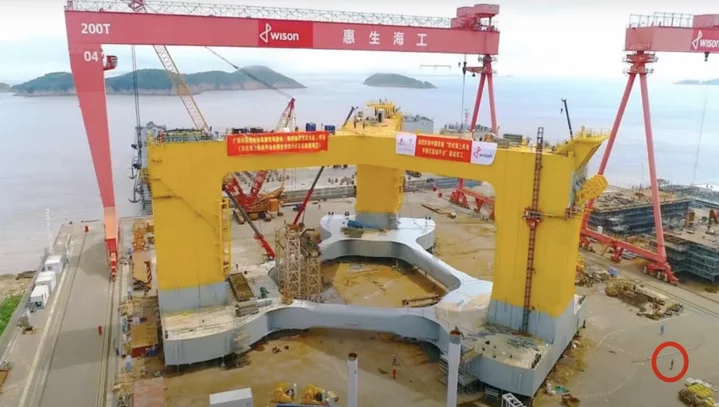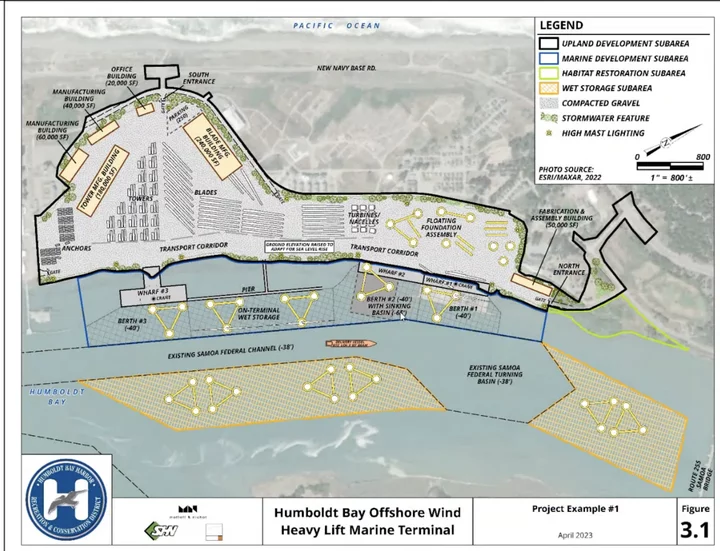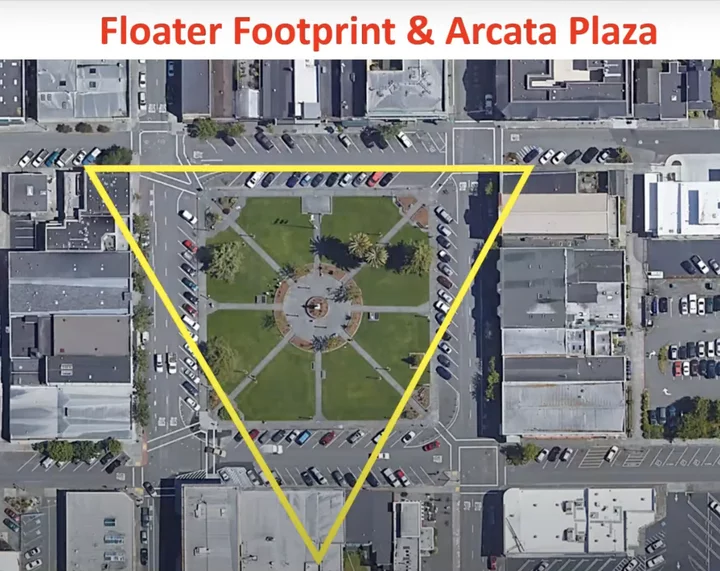An offshore wind turbine’s floating platform, measuring 100 feet tall and 425 feet long per side, being assembled onshore. (For scale, that’s an adult human circled in red in the lower right.) | Screenshot from Harbor District video.
###
The Humboldt Bay Harbor, Recreation and Conservation District — or let’s just call it “the Harbor District” for short — will host a public “scoping meeting” Wednesday evening from 5:30 to 7 p.m. at Eureka’s Wharfinger Building, located at 1 Marina Way.
What’s a scoping meeting, you ask? Well, the Harbor District recently announced that, per the rules of the California Environmental Quality Act, it is developing a Draft Environmental Impact Report (DEIR) for a major renovation of the Port of Humboldt Bay.
That’s right: The district is preparing to meet the needs of the multinational, federally stimulated offshore wind industry, and tomorrow night’s meeting will give the public its first opportunity to weigh in on the “scope” of environmental issues that should be included in the report.
The idea, as recently explained in a thorough and informative YouTube video featuring Rob Holmlund, the Harbor District’s director of development, is to transform the district’s largely vacant former industrial property on the Samoa Peninsula (home to the dilapidated remnants of the old pulp mill and Hammond Lumber Mill) into a state-of-the-art “heavy lift marine terminal,” a compound where the jaw-droppingly massive wind turbine components could be manufactured, assembled and then loaded onto ships.
(Watch that whole video if have an hour to spare and want to get a good baseline understanding of how the industry could impact our region.)
Here’s the Harbor District’s latest conceptual drawing depicting the Humboldt Bay Offshore Wind Heavy Lift Marine Terminal:
The Harbor District is justifiably optimistic that our (currently rather sleepy) Humboldt Bay is perfectly positioned to become the epicenter of offshore wind energy manufacturing and distribution on the West Coast, a place that could potentially host the lion’s share of industrial production and distribution for floating wind farms from Oregon down to Morro Bay.
Holmlund says there is “a suite of new industries that all need to be created on the West Coast [and] that currently do not exist.”
With the Biden administration calling for 30 gigawatts of offshore wind energy — enough to power 10 million homes — to be up and running by 2030, energy companies will need big supplies of everything from turbine blades and nacelles (the housings for the generating components) to mooring lines, towers and transmission cables.
All of these industries could — and by all sound reasoning — should be located right here on the shores of Humboldt Bay, according to the Harbor District. To that end, the district has entered into exclusive negotiations with multinational logistics firm Crowley, the company that aims to actually build the heavy-lift facility out on the peninsula.
While local conservation leaders are stoked about the carbon-emission-reducing potential of offshore wind development, they have voiced concern — right here on the pages of the Outpost, among other places — about just how green the port itself will be.
They point to the diesel-guzzling machinery — cranes, trucks, forklifts, etc. — that operate such ports, as well as the fossil-fueled tugboats and ships that could wind up hauling the massive infrastructure out to sea.
A community group called the Redwood Region Climate and Community Resilience (CORE) Hub has been closely monitoring this project and plans to have representatives at Wednesday’s meeting. In a voicemail left for the Outpost, a member of CORE Hub said representatives will be on hand to advocate for community benefits and protections for tribes and surrounding communities as well as the local fishery.
In a jointly authored opinion piece, local environmental leaders recently called on the Harbor District to commit to a zero-emissions green port by employing such emerging technologies as electrified terminal equipment, on-shore power stations for idling ships, fully electric tugboats and battery storage facilities.
“We would love to see a commitment to a green port from the get-go,” said Jennifer Savage, a 20-year resident of the Samoa Peninsula (and a friend of mine). “It only makes sense that a project designed to move us away from fossil fuels would be clean and climate-friendly itself.”
While the Harbor District has insisted that its port-development project extends only as far as the harbor entrance — which is to say it’s distinct from the offshore wind farms themselves — Savage and others argue that all aspects of the development, including support activities, should be identified and analyzed as part of the Harbor District’s environmental review process.
Jennifer Kalt, executive director of environmental nonprofit Humboldt Baykeeper and one of the authors of the recent opinion piece, said this kind of advocacy isn’t about obstructionism.
“It’s hard to say ‘zero emissions’ without people thinking that we’re asking them to reach an unachievable bar, but that’s not at all what we’re doing,” she said. “We don’t want to make perfect the enemy of good. We just want it to be planned right from the start.”
Kalt noted that much of the technology to facilitate offshore wind energy at this scale — from the massive floating turbines to the electrical transmission infrastructure — is still years away, so the Harbor District should be willing to rely on advances in green electrification options, too.
“This is going to be a publicly funded project to a great extent, so we need to make sure that the public trust [resources] in Humboldt Bay and all the surrounding communities … will be protected,” Kalt said.
Savage also called on Crowley to enter into a Community Benefits Agreement that includes commitments to hire locally and provide job training such as internships and apprenticeships.
“I think it’s really important that the Harbor District and Crowley see the community as valuable partners and make real commitments to make sure everything is done right from the beginning,” Savage said.
The Harbor District’s Notice of Preparation of Draft Environmental Impact Report, which you can download by clicking here, will be circulated for a 30-day review and comment period. If you can’t make it to the meeting Wednesday, you can also submit comments by emailing Rob Holmlund at districtplanner@humboldtbay.org.
Remember: This project is about port development, not the offshore wind farms. Check back later this week for a report on Wednesday’s meeting.
Below, one more image to convey the gob-smacking size of the floating platforms, atop each of which will be mounted turbines that are more than 1,000 feet tall from the ocean surface to the tip of the blades. If you were somehow able to lower one of the platforms into the heart of downtown Arcata, it would cover virtually the entire Arcata Plaza and obliterate several surrounding businesses:
Screenshot.
###
PREVIOUSLY:
- Harbor District Announces Massive Offshore Wind Partnership; Project Would Lead to an 86-Acre Redevelopment of Old Pulp Mill Site
- Offshore Wind is Coming to the North Coast. What’s in it For Humboldt?
- ‘Together We Can Shape Offshore Wind for The West Coast’: Local Officials, Huffman and Others Join Harbor District Officials in Celebrating Partnership Agreement With Crowley Wind Services
- SOLD! BOEM Names California North Floating and RWE Offshore Wind Holdings as Provisional Winners of Two Offshore Wind Leases Off the Humboldt Coast
- California’s Aging Electrical Infrastructure Presents Hurdle for Offshore Wind Development on the North Coast
- Crowley — the Company That Wants to Build a Big Wind Energy Facility on the Peninsula — Will be Opening Offices in Eureka



CLICK TO MANAGE